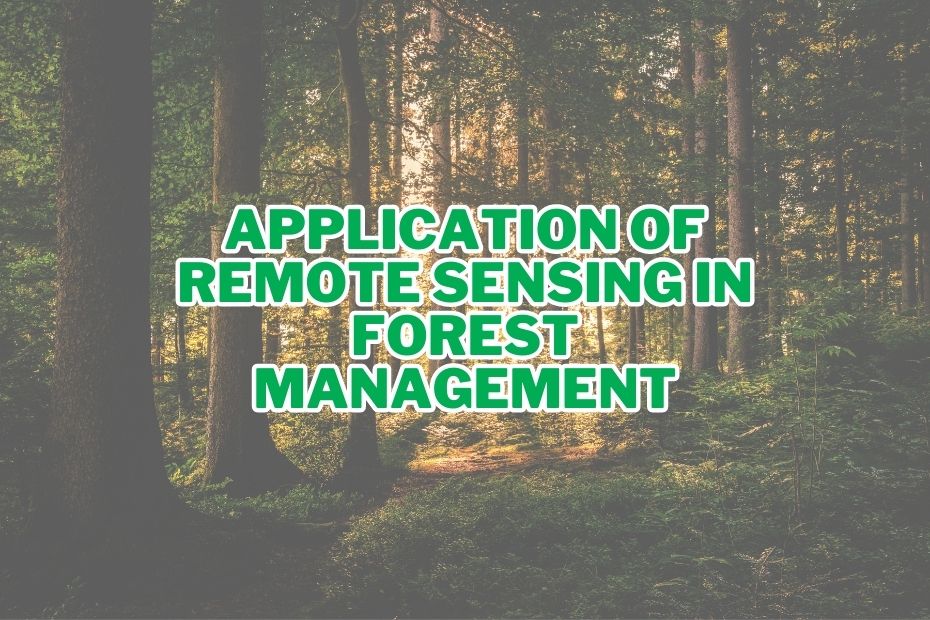From the heart of sprawling cities to the most remote corners of the earth, forests play a critical role in maintaining ecological balance and supporting human livelihoods. Modern technology has lent a hand to forest management, with one such tool being remote sensing. Let’s explore the role and application of remote sensing in forest management.
Remote Sensing enables the identification of forest cover, biomass estimation, and detection of changes over time.
Role of Remote Sensing In Forest Management
The Importance of Remote Sensing
Managing our global forests responsibly requires accurate and timely information. Remote sensing steps in as a comprehensive, efficient, and cost-effective method to gather this information.
How Remote Sensing Works in Forest Management
Satellites and aircraft equipped with remote sensors provide a bird’s-eye view of forests, capturing detailed information about the forest structure, health, and changes over time. This data is then processed, interpreted, and used for various forest management tasks.
Application of Remote Sensing In Forest Management
The application of remote sensing in forestry is revolutionizing how we manage our green resources, offering new opportunities for conservation, sustainability, and industry growth. Remote sensing technologies such as satellites, drones, and Light Detection and Ranging (LiDAR) provide essential data for effective forest management, transforming how we view and interact with these critical ecosystems.
1. Mapping and Monitoring Forest Cover
The first step in efficient forest management involves accurately mapping and monitoring forest cover. Remote sensing allows for large-scale data collection over extensive forested areas, enabling precise vegetation mapping. This technology distinguishes different forest types, identifies changes in forest cover, and quantifies these changes over time. This mapping technique helps foresters make informed decisions about the management and protection of forest resources.
2. Forest Fire Detection and Monitoring
Forests are often victims of wildfires, causing significant ecological and economic damage. The application of remote sensing in fire detection and monitoring has proven vital. Remote sensing satellites can detect fires even in the most remote regions, providing real-time alerts. Thermal and infrared sensors can identify fire-prone areas, aiding in the early detection and efficient management of forest fires.
3. Forest Inventory and Biomass Estimation
Remote sensing technology plays a pivotal role in forest inventory and biomass estimation. It helps estimate tree heights, diameters, and volumes, contributing to the assessment of forest resources. Additionally, remote sensing data is key for estimating carbon stock, a crucial aspect of climate change studies, and formulating policies for carbon sequestration.
4. Forest Planning and Management
The use of remote sensing in forest planning and management has been transformative. The wealth of information provided by these technologies allows for informed decisions about harvesting, reforestation, and overall forest management practices. It also aids in the development of strategies to minimize the impact of natural disasters, pests, and diseases, ensuring the longevity and health of our forests.
5. Deforestation Monitoring
Monitoring deforestation has never been more critical due to climate change concerns. Remote sensing provides the ability to detect and quantify deforestation on a global scale. As part of the remote sensing applications in deforestation, the technology helps identify deforestation hotspots and track changes over time. This information is critical for implementing effective strategies to combat deforestation.
6. Forest Health and Disease Monitoring
Remote sensing technology is crucial in identifying signs of forest disease and deterioration in tree health. By detecting subtle changes in canopy color or forest density, we can anticipate disease outbreaks or pest infestations, enabling proactive intervention. Remote sensing also helps monitor recovery efforts, offering insights into the success of implemented management strategies.
7. Wildlife Habitat Assessment
In assessing wildlife habitats, remote sensing plays an integral role. The technology provides critical data regarding vegetation types, forest structure, and changes over time, which contribute to understanding wildlife habitat needs and responses to habitat changes. This knowledge is essential for preserving biodiversity and maintaining healthy, functioning ecosystems.
8. Watershed and Hydrological Analysis
Remote sensing offers invaluable tools for watershed and hydrological analysis in forested areas. It facilitates the monitoring of surface water bodies, the assessment of water quality, and the prediction of hydrological patterns. Understanding these dynamics can help manage water resources efficiently and sustainably in forest ecosystems.
9. Forest Conservation and Biodiversity Assessment
Lastly, remote sensing is a potent tool for forest conservation and biodiversity assessment. The data collected provide insights into species diversity, ecosystem functioning, and changes in biodiversity over time. These applications of remote sensing in biodiversity conservation inform and empower conservation efforts, making a significant contribution towards preserving our planet’s rich biodiversity.
Conclusion
The application of remote sensing in forest management is transforming the way we understand, manage, and conserve our forest resources. The data provided by this technology offers a detailed, birds-eye view of forest conditions and changes, aiding in decision-making processes across the spectrum of forest management. The future of sustainable forest management lies in further harnessing this innovative technology, marrying data-driven insights with proactive conservation efforts.
FAQs: Application of Remote Sensing In Forest Management
How does remote sensing help in forest management?
It provides a comprehensive, efficient, and cost-effective method for gathering information about forest structure, health, and changes over time.
Can remote sensing help detect forest fires?
Yes, it plays a crucial role in predicting, monitoring, and assessing damage from forest fires.
Can remote sensing be used to estimate forest biomass?
Absolutely! It provides an efficient and accurate way to measure forest biomass on a large scale.
Can remote sensing detect forest pests and diseases?
Yes, remote sensing can aid in the early detection and monitoring of forest pests and diseases by analyzing changes in vegetation health and patterns.
